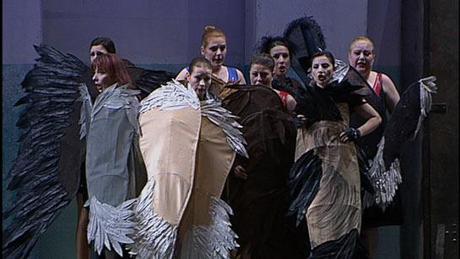Brünnhilde (Renate Behle) wears a sports coat, identical to Wotan's, and clownish makeup. In the opening of Act II, she is helping her father arrange miniature statues--standing in for human destinies--in the unfurnished basement of a house, where Wotan lounges in track pants. (Under the circumstances, I'm tempted to use the odious term "man cave.") He dons blazer and over-sized sunglasses for the confrontation with Fricka. The staging, then, seemed to me to take Fricka's side. Wotan is a self-centered shirker of responsibility; Fricka is an elegantly dressed woman with a mission, and morals (sung with conviction by Tichina Vaughn.) I watched this twice, dutifully, and just was not drawn in by Wotan's monolog. I didn't get a sense of his anguish, nor the scope of the matters at stake. This staging of Siegmund's death managed to leave me dry-eyed. Need I emphasize that this is hard to do? Wotan, Brünnhilde, Hunding, and Siegmund stood behind music stands holding bullhorns while automata built of scrap material raised and lowered swords behind a scrim. After the Siegmund-robot fell, Siegmund walked over to Wotan, who contemplated the scene with him. This leads me to my main criticism of the production: emotionally, it fell flat.

Valkyries, Act III. Via Wagneropera.net
The Ride of the Valkyries, well sung, has been dubbed the "Silly Walk Walküre" by Wagneropera.net, a label on which I cannot improve. Eva-Maria Westbroek is a nice treat as Gerhilde, playful and sexy, as well as rich-voiced. Wotan reading a newspaper and stonily ignoring Brünnhilde during "War es so schmaehlich" struck me as a painfully realistic depiction of paternal displeasure. I thought having them on separate levels of the stage for the entire scene, however, undermined the poignancy of their laments for intimacy-about-to-be-lost. Wotan intermittently observes Brünnhilde on a security camera he has, which strikes me as interesting, but didn't seem to fit with an overall idea of the production. He seems preoccupied and distracted. True, he breaks his "staff," here a long straw of the kind Tom Sawyer might chew, into pieces when describing his "ewige Gram." But I wasn't feeling it. Wotan finally looks directly at his daughter when she is making her plea for the magic fire, and they reach out as for an embrace; but he turns away at the last minute. Brünnhilde sits dejected at a table identical to the one found in Hunding's hut in Act I. I figured that one out: the table and chairs of an oppressive patriarchy that shops at Ikea! Wotan, drunk on the whiskey he has been imbibing, staggers about in the tie that he dons partway through the scene. He sings "Der Augen leuchtendes Paar" to the TV screen. It is a poignant choice--a loving father unable to show his love--but I didn't feel that it was really supported or explored much by Jan-Hendrik Rootering's Wotan. (Note: the only Walküre-Wotans I've heard live are Morris and Terfel, so I am spoiled by performances of great emotional depth and nuance.) Again, Zagrosek and the orchestra of the Staatsoper contributed clean, precise playing; this sometimes verged on feeling too clean, for me, given the larger-than-life emotions of the opera. The tempi also could seem measured where I wanted them to be running away. This may well have been a noble attempt by the conductor and orchestra to support the interpretation of the production. Would that it had been more rewarding.
